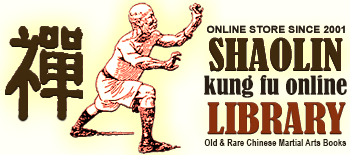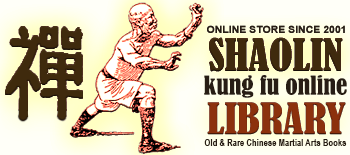
Short Historical Essay on Master Lam Sai Wing /Chapter 2/
WRITTEN BY HIS DISCIPLE ZHU YUZHAI. AS RELATED BY ZHANG SHIBIAO FROM PANGYU. THE TWELFTH YEAR KUIHAI OF THE PEOPLES REPUBLIC (1923), THE FIRST MONTH OF THE SUMMER.
Introduction - Master Lam Sai Wing Sets Up a School for Training the Fighting Arts in Canton - Master Lam Sai Wing Becomes a Disciple of Wong Fei Hung - Lam Sai Wing and Wong Fei Hung Talk to a Monk Called "The Iron Head" - Master Lam Sai Wing Gaines the Upper Hand over the Monk Called "The Iron Head" - Master Lam Sai Wing Deals with a Band of Rowdies - Master Lam Sai Wing and his disciples enter "The Society for Cooperation" with the aim of mutual confrontation to robbers and cutthroats - Master Lam Sai Wing is Lured into a Death Trap - Master Lam Sai Wing becomes the Chief Instructor in the army of Fujien province.
CHAPTER 2.
Master Lam Sai Wing Sets Up a School for Training the Fighting Arts in Canton.

That was the time when Manchu dynasty Qing (1644-1911) fell down and the People's Republic (1912-1949) was in the process of formation. The Chinese people had no moral supports during that time of confusion and lawlessness. At quiet nights Master Lam Sai Wing meditated on how to devote himself to good deeds and heavily sighed. He said that at such a time a brave man could not waste his powers and had to do his highest duty for the sake of the people. One must devote to it his whole life, refuse trade and handicraft, "take a knapsack on his back and set off" in search of friends and mentors for himself to enrich his knowledge. Should not one do self-sacrifice for the well-being of the society?
Masters of fighting arts in northern provinces lived more or less well, but in the southern Guangdong province they had to seek for means of subsistence or expect official vacancies and to solve other every-day problems. That's why it was extremely hard to find disciples to pass fighting arts from generation to generation.
Nevertheless, at those hard times followers who wished to learn the ancient traditions were found. Military commanders Liu and Cheng, as well as Wu Quanmei who held "tidu" post (a military commander of all troops in a province) dedicated themselves to Kung Fu. There were more than 20 disciples in Wong Fei Hung's school and some trainers. They united, set up their own school and enrolled disciples.
The Lam's school opened in Canton (Guangzhou) quickly become very popular and Master Lam Sai Wing became famous as a great specialist in fighting arts. One should take into account that the Chinese Pugilism and Fencing interlaced with Dao practice are the most complicated. The whole technique imitating actions of the people and animals has a hidden sense. This technique is well elaborated and effective; if a man who observes all required conditions uses it, he wins a quick victory! This is the basic feature of the Chinese Fighting Arts.
Some time later, a man called the Bald-Headed, also native to Guangdong province, appeared in Canton. On hearing on the famous Master Lam, this envious man tried to discredit Lam Sai Wing by saying that he was stronger than Master Lam. One day he made a surprise visit to the Master Lam's school and burst into the room where the fighters trained. The Bald-Headed was unceremonious and impudent in complete disregard of everybody. He planned to set up his own school and to enroll disciples for himself. He wished to measure swords with Master Lam and challenged him. Three times Master Lam Sai Wing tactfully refused, yet the Bald-Headed forced him to fight; Lam had no any way out but to fight. The place for the fight was found outside the city. Master Lam Sai Wing overpowered the Bald-Headed who acknowledged his defeat and humbly expressed his desire to become Lam's disciple. Later, after training at the Lam Sai Wing's school he also became a well-known master.

CANONICAL BOOKS BY LEGENDARY GRANDMASTER LAM SAI WING (1860 - 1943)

Lam Sai Wing. Taming the Tiger (工字伏虎拳)
The book scrutinizes an old canonical form (the Tao) of the Southern Shaolin Kung Fu, the Gung Gee Fook Fu.
According to the legend, the founder of the Hung Gar style, Hung Hei Goon studied this form under the tutorship of Southern Shaolin best fighter, a Master of the Tiger Style abbot Gee Sin Sim Si.
The Quintessence of Southern Shaolin Kung Fu - classical Fighting Methods from the book GUNG GEE FOOK FU KUEN:
"The claws of a Black Tiger"
"A fierce Tiger hiding in a cleft"
"The Bull strikes with its horn, makes a turn and breaches the sky"
"The arm of the Golden Dragon"
"To tear out a Phoenix's eye"
"The Tiger striking with its tail"
"The two Dragons steal pearls"
"The Snake raises up its head"
"The Celestial Dragon wags its tail"
"The Golden Dragon carries gifts in its claws"
"The hand that calls out a Ghost"
and others...

Lam Sai Wing. TIGER AND CRANE (虎鸖双形拳)
The book deals with the most popular and probably the most monumental form of the Hung Gar Kung Fu style. This form, known as The Tiger and the Crane, was created in the late XIX century by Lam Sai Wing's teacher, an unrivalled master of Kung Fu Wong Fei Hung. The Tiger's extremely tough, fierce and lightning-fast attack are balanced against and supplemented by the softer and smoother techniques of the Crane. The "tough" and the "soft" combine in a harmony.
The Quintessence of Southern Shaolin Hung Gar Kung Fu - classical Fighting Methods from the book Fu Hok Seung Ying Kuen:
"A Fierce Tiger Pressed Himself to the Ground"
"Tiger's Eye, Leopard's Blow"
"The Hungry Tiger Catches a Ram"
"The Tiger Goes Out from his Den"
"The Fierce Tiger Descends a Mountain"
"The Tiger Tramples On Wolves and Jackals"
"Claws of the Black Tiger"
"A Fierce Tiger Pushes the Mountain"
"The Dragon Hid, the Tiger Jumped Out"
"The Fierce Tiger Scratches Sand"
" Tiger's Roar and Crane's Call"
"A Crane Beak", "One Leg of a Flying Crane"
"A Hungry Crane Standing on One Leg"
"A Hungry Crane Catches Shrimps"
"Crane Crest", "The Monkey Steals a Peach"
"The Wild Goose Sits Down on the Sandbank"
"Prancing Unicorn", "Butterflies Depart in Flight"
"The White Horse Hoofs"
"Arhat Goes Out from the Cave"
"Eight Drunken Celestials"
and others...

Lam Sai Wing. Iron Thread (鐵綫拳)
The Iron Thread Form (Tid Sin Kuen) was created by Tid Kiu Sam (Iron Bridge III), one of the best martial artists in the history of China. His real name was Leung Kwan (1813-1886). He was one of the famous Ten Tigers of Guangdong. Tid Kiu Sam was born in the town of Nanghai, Guangdong province. He, the third child in the family, became a disciple of a monk from the Southern Shaolin Temple, Gwok Yan. Gwok Yan was one of the greatest masters of the Southern Shaolin Hung Gar Kuen school. He was known along the whole length of the Yangtse river. Through the years Tid Kiu Sam passed his knowledge down to one of his students, Lam Fook Sing. Some time later Lam Fook Sing taught Wong Fei Hung (1847-1924) and the latter Wong Fei Hung taught Lam Sai Wing (1860-1943).
The Iron Thread is considered as the highest form taught in the traditional Southern Shaolin Hung Gar Kung Fu system. This method belongs to a branch of "hard", or fighting Southern Shaolin Qi Gong (Chi Kung) and considered as "Internal Training". A master of the Iron Thread can withstand, with no consequences, the strongest of blows, including ones with heavy objects or cold steel, bend thick iron rods with his hands, and his "rooting power" is so strong that he cannot be displaced by a group of strong people. In addition, this wonderful method strengthens all internal organs, bones, muscles and sinews. The entire body thrives and rejuvenate.



